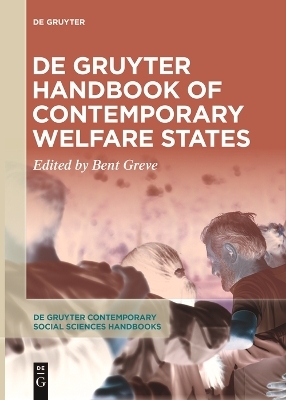
De Gruyter Handbook of Contemporary Welfare States
De Gruyter (Verlag)
978-3-11-072470-7 (ISBN)
Welfare States have evolved and developed over now close to the last 150 years, although not in all countries at all times in the same direction implying that they are still very diverse. There was a time of golden growth of the welfare states shortly after the second world war, and then after the oil-price shock in 1th 1970's has, at least since OECD's pathbreaking book been argued to be in crisis. This has been followed up with discussions of dismantling of the welfare states , and continued after the financial crisis as with further changes, often under the label of austerity and retrenchment.
Over the year's elements either expected to have or having an impact on the development has been many and varied. The elements have, for the same reasons, not been similar across countries and welfare states. However, there are some common traits that have and can be expected to influence contemporary welfare states development also in the years to come. This includes aspects of globalisation, regionalisation, new technology, demography, voter's expectation and re-structuring of societies. There are however also new challenges to welfare states. The financial crisis showed the vulnerability of welfare states economic systems, but also that the ability to have a stable economy influences the options and ability to continue and be able to afford a welfare state. The recent COVID19 crisis has showed the possible double pressure of welfare states, including if there are strong challenges in several areas at the same time - in this case health and economy then a strong pressure on the sustainability of the welfare state is at play. This combined with the increasing inequality has implied both economic and political problems in a number of countries, and thereby creating new variants of the existing and possible crises in the future. These crises, including the assessment of whether it is in fact a crisis, may vary according to ideas, but also how the individual country is positioned in relation to solving it. At the same time, a number of the aspects mentioned before continues to be possible threats and pressures on welfare states - such as demographic change and the development of new technology. Possible topics is described later.
This book thus takes the "temperature" of welfare states, while also trying to assess the strength of the challenges for different types of welfare states/regimes. It analyses and compares several welfare state models - Nordic; Continental; Liberal, including the US; Southern-Europe; Eastern-Europe; China; South-East Asia - and also points to future opportunities.
Bent Greve, Universität Roskilde, Dänemark.
There will be four sections.
The first will, beside the introduction, deal with research methods to understand and grasp the challenges for contemporary welfare states. This will include how to measure change, but also look into issues of big data as a way to follow what is going on, and, as well looking into evidence based social policy.
The second will, in order to have a background for and understanding of the challenges, give a presentation of a number of welfare regimes, this given that the challenges might vary due to history, economy and demography among other things.
Then the third will look into a number of possible issues that is or might come to be a challenge for the welfare states not only now, but also in the years to come, see more below.
The fourth and last will show future research need and conclude what we know about possible upcoming avenues for the welfare states.
Section 1
1. Introduction
This chapter will set the scene for the book and present the approach to the book, including a short presentation of the content of each chapter.
2. Measuring change
In order to discuss change and challenges for welfare states, it is necessary to have a knowledge of how to actually measure change. This includes understanding which parameters can be used (i.e. quantitative data on expenditure, redistribution), but also on changes in rules for, for example, access to a number of social benefits. In addition, change may have an impact on staff's experience of working life and users 'experience of quality of services, but at the same time a need to be aware of that users' and staff's perspectives may be influenced by subjective interest. The time horizon for change can also be important.
3. Approaches to analyse welfare state change
In continuation of Chapter 2, this chapter looks more closely at what approaches can be used to analyse welfare states, both individually and comparatively. The overview should contribute to an understanding of whether explanations of changes are also included, and whether it can be seen that ideas have a bearing on development. Legitimacy as a possible cause of change and how it is possible to analyse welfare states legitimacy is also included.
4. Big Data
The possibilities of analyzing ever-increasing amounts of data can be an opportunity to create new knowledge that can be used in efforts for citizens, for example in the health sector, to provide better knowledge of when, for example, changes in the economy are coming. At the same time, Big Data increases the risk of monitoring taking place and the opportunity to try to influence, for example, elections, such as what have been argued in relation to the vote in the UK on leaving the EU. The paradox is that, on the one hand, more opportunities are opened, but at the same time the risk of someone becoming better able to influence what is going to happen in a welfare state is increased.
5. Evidence based social policy
It has always been, and probably always will be so, that there are more wishes for the welfare state than it is possible to finance. Therefore, in all types of welfare states, there will be a need to use evidence-based knowledge. The question here is not only what is the best type of knowledge, although it will be briefly presented, but to a greater extent its applicability and what potential challenges its use will have in the development of welfare states.
Section 2 Welfare States and Regime
These five chapters aims at setting the scene for the reference and discussions in Section 3 on how different welfare regimes can be expected, based upon the knowledge of their central structure, to understand and reflect upon how changes will influence the development. They are thereby also expected to be shorter than the other chapters in the book. Thus, the common format for these five chapters will be:
a) Introduction
b) State of the art - what do we know about the regime in an ideal-typical understanding, and central goals and achievement over the last ten years.
c) An analysis of their preparedness to cope with challenges given recent years development including fiscal pressure on welfare states
d) Conclusion
6) Nordic
7) Continental
8) Liberal, including the US
9) Southern-Europe
10) Eastern-Europe
11) China
12) South-East Asia
Section 3 Specific topics
13) Demographic changes
The elements included in the chapter will include not only the historical discussion of the consequences of the greying of societies, but also change in family formation, including more singles, but also the challenges of the work-family life balance and the need for care for children. This will include a broader debate hereabout, including, as a not often discussed topic, whether welfare state policies might influence fertility rate.
14) Health
Health and health policy have for a long time been a central welfare state issue. This is due to the pressure on health care costs which, in addition to demographics, are due to, among other things, new technology, new treatments and voters' expectations. In recent years, inequality in health and, for example, differences in life expectancy are a new topic. How to get the interaction between professionalism, financial resources, inequality, and expectations to play together is central. Similarly, the opportunity to prevent the need for treatment applies.
15) COVID19 as a case
COVID19 has pointed to a new issue for welfare states - and not just in relation to health care. How to be prepared for a possible future global virus pandemic and how this may affect the ability to fund welfare states as well as the impact on community cohesion. This appear to be increasing problems. How can such possible situations be prevented and what consequences might possible initiatives have for the way different societies is functioning?
16) Long-term care
Elderly care has been a growing area as a number of welfare states have taken initiatives to support those in need, even though how this is defined is not always clear. Reasons for interventions includes the increasing number of elderlies. But at the same time, it is an area where the approach has been very different between welfare states from leaving it largely to the family, to the market to a large state involvement, and also a number of variations hereof. At the same time, an area where healthier lifestyles and rehabilitation can be ways of reducing possible pressure on the welfare state's tasks. It is also an area where there is a risk that elderly people will become lonely, which can have negative personal and social consequences.
17) Pension
For a long-term reform of pensions as a consequence of both demographic changes and economic pressures has been on the agenda. This chapter looks into the changes across different welfare states, but also how and if these changes will ensure both the economic resources available and the living standard for different groups of elderly, especially dependent on their labour market careers. Thereby the chapter will also include issues related to inequality.
18) Migration and ethnicity as challenges and opportunity
Migration and perceptions of consequences hereof for welfare states have been discussed for a number of years. This applies to migrations both within the EU and from countries outside the EU. Contrasting perspectives include that while a number of industries appear to be dependent on labour from other countries, often at low wages and under poor working conditions, other workers find that foreign workers are pushing their wages and working conditions. This cross-pressure for welfare states is the focal point of this chapter, albeit also including refences to and discussions pertaining to the issue of legitimacy and deservingness.
19) Education
Education has for a long time been a central aspect in relation to a number of societal challenges - from employment and democracy to inequality. Education has been seen as an important development of human capital - and indirectly also for social capital. This chapter looks in particular at why there are still many young people who do not receive any qualifying education, as well as why lifelong learning, including continuing education and training, has still not developed any more despite political rhetoric hereabout. This is also seen in the light of the fact that future technological developments point to the fact that having a number of competences and constantly developing them becomes central in order to maintain a position in the labour market.
20) Inequality - across and within countries
Inequality has been rising in a large number of countries over the past 10-15 years. The very rich have become even richer and the distance between the highest and lowest wages has increased. It has challenged the cohesion of welfare states and is open to discussions about what and how it is possible to do something about it. Consequences of inequality as well as possible instruments for welfare states to change will be key elements of the chapter. This will further be analysed within and across a number of welfare states.
21) Poverty
Poverty globally has been declining. However, that does not mean that the goal of eradicating extreme poverty has been achieved. At the same time, in rich welfare states, a large proportion still live in relative poverty. The chapter has the ambition, after a brief description of the development of poverty, to look more closely at the societal consequences of poverty, but also if desired by policy makers, which instruments can change this, including whether different types of welfare states have different opportunities to change them.
22) Employment/unemployment
Employment and unemployment have been central issues for welfare states for many years. This is due to both the desire for growth in production, but also that unemployed people may need social security and an active labour market policy. The many nuances and elements are included, including that there is no sure knowledge of the effects of active labour market policy, but conversely that there is knowledge that financial security can contribute to better quality of life for the unemployed. In addition, there is pressure on the labour market as a result of new technology - and thus a large number of people will be exposed in the coming years.
Section 4 Some Cross-cutting issues
23) Sustainability
The sustainability of welfare states (economically as well as environmentally) is challenged by whether they are able to withstand emergency crises, whether it is a financial crisis or a COVID-19 crisis. Technology is also challenging - both on the expenditure side in a number of areas and on the income side by increasing the risk that more people are outside the labour market. A central issue is how balanced public budget and equilibrium in the longer term, including avoiding high public debt, will make it easier or more difficult to manage unforeseen crises.
In many countries and populations, there is a further desire to contribute to the development of sustainable communities. The question is here how and, if so, in what way this contribution can be compatible with wishes for more welfare and the ability to finance welfare states. In particular, the focus will be on environmental sustainability, but also gender equality will be included.
24) Populism
Populism and populist individuals and parties have presumably influenced the development of society in a number of countries. Typically, on the basis that they argue that they represent the people against the elite, but also with attitudes and assessments of who has and / or should have access to a range of social welfare benefits. It can affect both who gets and how much they get. In doing so, it can affect the development of welfare states, whether it is more right-wing or left-wing populism.
25) Behavioural public policy
Influencing the behaviour of citizens can be done in many different ways, including through legislation and the application of different taxes and duties. In recent years, there has been a focus on other ways to get people to change their behaviour in a number of areas by nudging people to make what is termed the right choice. It is often referred to as libertarian paternalism indicating that people have a freedom not to do it, but the advice is that they should. Consequently, behavioural economics and behavioural policy can be said to be new areas that change welfare states, but which in principle also have a risk of abuse by both the public and private sectors.
26) North-South divide - globally and within the EU
Welfare states are challenged not only by national opportunities but also by global uncertainty and inequality. The possible desire for greater global equality is pushing for the more prosperous countries to transfer and contribute to the development of poorer countries, and this can put pressure on the ability to finance welfare states. In addition, especially within the EU, there are also elements in this that affect the possibility of developing national welfare states, while at the same time guaranteeing certain minimum rights for citizens. In addition, the influence of national labour markets on international economic development has an impact.
27) Incentives - disincentives - the benefit side of the welfare states
Incentives have been a central part of the discussions on the development and layout of welfare states. For example, there has been a focus on whether there were enough incentives to take a job and whether taxes and fees could adversely affect behaviour. The interaction between the social security system and the behaviour of people has thus been discussed. In addition to the size of social benefits, this has also had an impact on conditions for receiving social benefits. At the same time there has been discussion on unconditional basic income.
Section 4 Future research and Conclusion
28) Concluding reflections and the need for future research
This final chapter will both look into and how to interpret what the challenges might have of consequences for contemporary welfare states as well as look into what we need to know more about if we want a specific development of the welfare states. It will also be pointing towards a number of the recommendations during the book to what to do if there is a wish to solve some specific threats and problems in welfare states.
| Erscheinungsdatum | 27.05.2024 |
|---|---|
| Reihe/Serie | De Gruyter Contemporary Social Sciences Handbooks ; 1 |
| Zusatzinfo | 10 b/w ill., 10 b/w tbl. |
| Verlagsort | Berlin/Boston |
| Sprache | englisch |
| Maße | 170 x 240 mm |
| Gewicht | 939 g |
| Themenwelt | Sozialwissenschaften ► Politik / Verwaltung ► Politische Theorie |
| Schlagworte | Nachhaltigkeit • Social Policy • Sozialpolitik • Sozialstaat • sustainability • Welfare State |
| ISBN-10 | 3-11-072470-7 / 3110724707 |
| ISBN-13 | 978-3-11-072470-7 / 9783110724707 |
| Zustand | Neuware |
| Haben Sie eine Frage zum Produkt? |
aus dem Bereich


